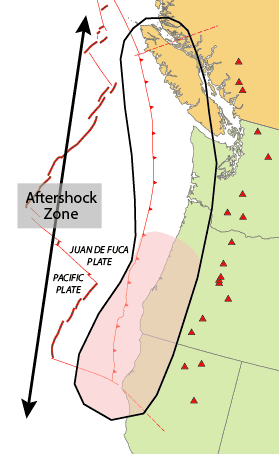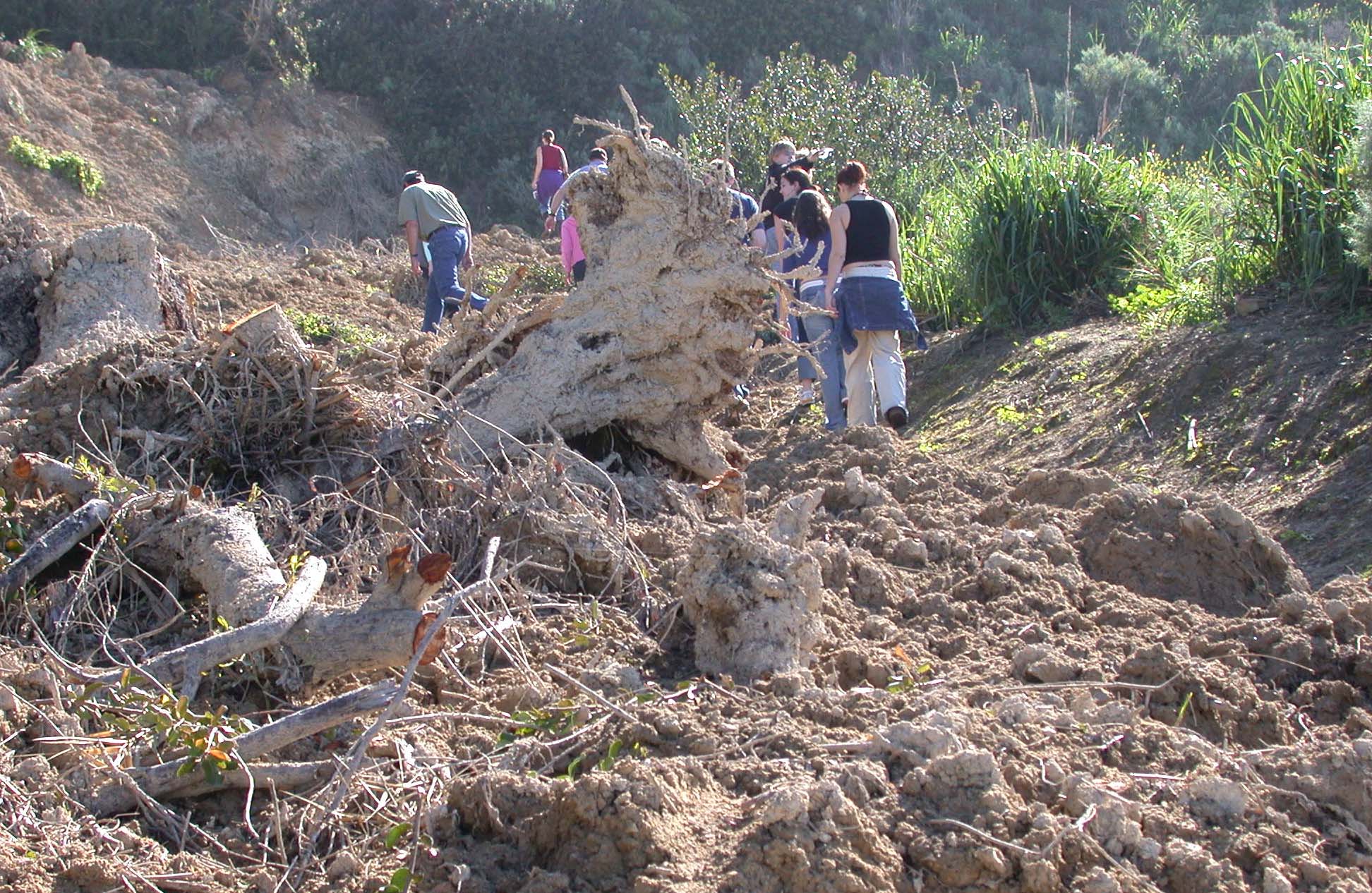Director's Statement
For many of us, this past year brought into focus the ways in which natural hazards can impinge on society. On the day after Christmas, a magnitude 9.0 earthquake struck along the subduction zone west of Sumatra. This was the largest earthquake in the past 40 years, and the combined seismic shaking and resultant tsunami killed over a quarter million people. The rupture length was equivalent to a rupture in the Cascadia subduction zone that spans from northern California to British Columbia. Paleoseismologists have reconstructed a Cascadian rupture of this size that occurred about 300 years ago. Data gathered on past quakes in Cascadia (and southern California) is underpinning better predictions of when the next is due. Closer to home, two days after Christmas marked the beginning of the wettest 15-day period in the records of Southern California (since the late 1800s). Landslides and mudflows closed three of the four highways serving Santa Barbara, and at La Conchita, a major slide buried homes and killed 10 people. Heavy rains following an extensive fire season produced major erosion and sediment flows throughout the winter months. Here at the Institute for Crustal Studies, our members have been involved with analyzing these events with research goals that range from understanding fundamental processes, such as the dynamics of earthquake ruptures, to developing predictions for their societal impacts. These events have also provided great "teaching moments" to bring the real-time aspects of natural hazards into classrooms and field trips.
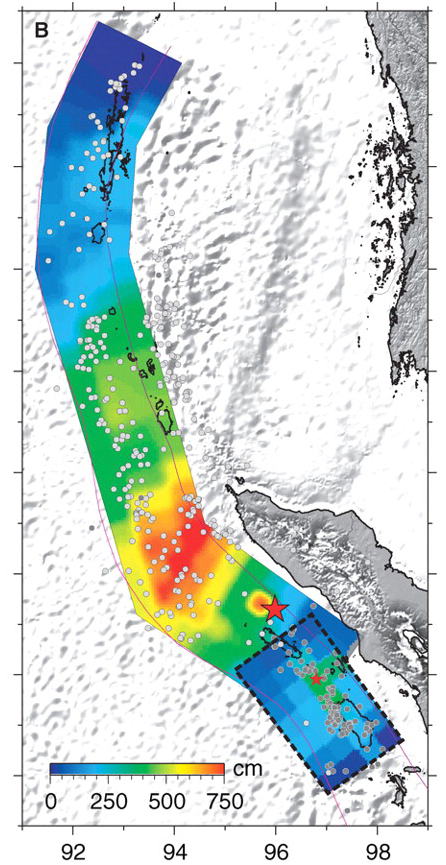 |
|
Established over 18 years ago, ICS was conceived as an interdisciplinary unit focused on the Earth's crust: the evolution of the crust through time and space as discerned from an integrated geological-geophysical perspective, the natural resources contained within the crust and at its surface, and the natural hazards that result from geological processes acting within it. Since then, the mission of ICS has diversified considerably and encompasses a broader swath of disciplines than ever before. Remote sensing of tropical rainfall, groundwater hydrology, Quaternary climate change, and astrobiology are presently studied by ICS researchers. In conjunction with this diversification, the number of faculty participants and principal investigators has steadily grown, as has the total funding administered through ICS.
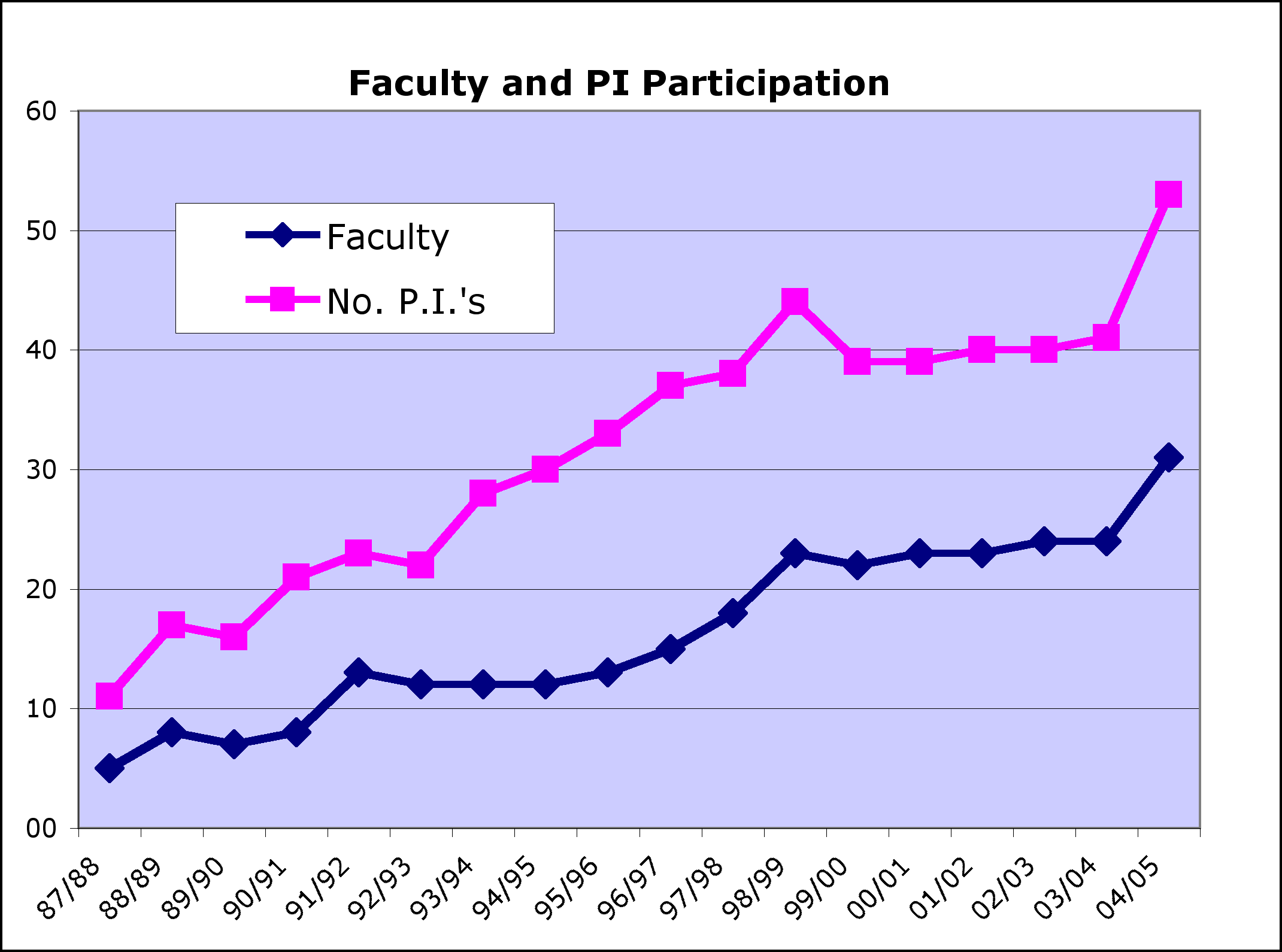
|
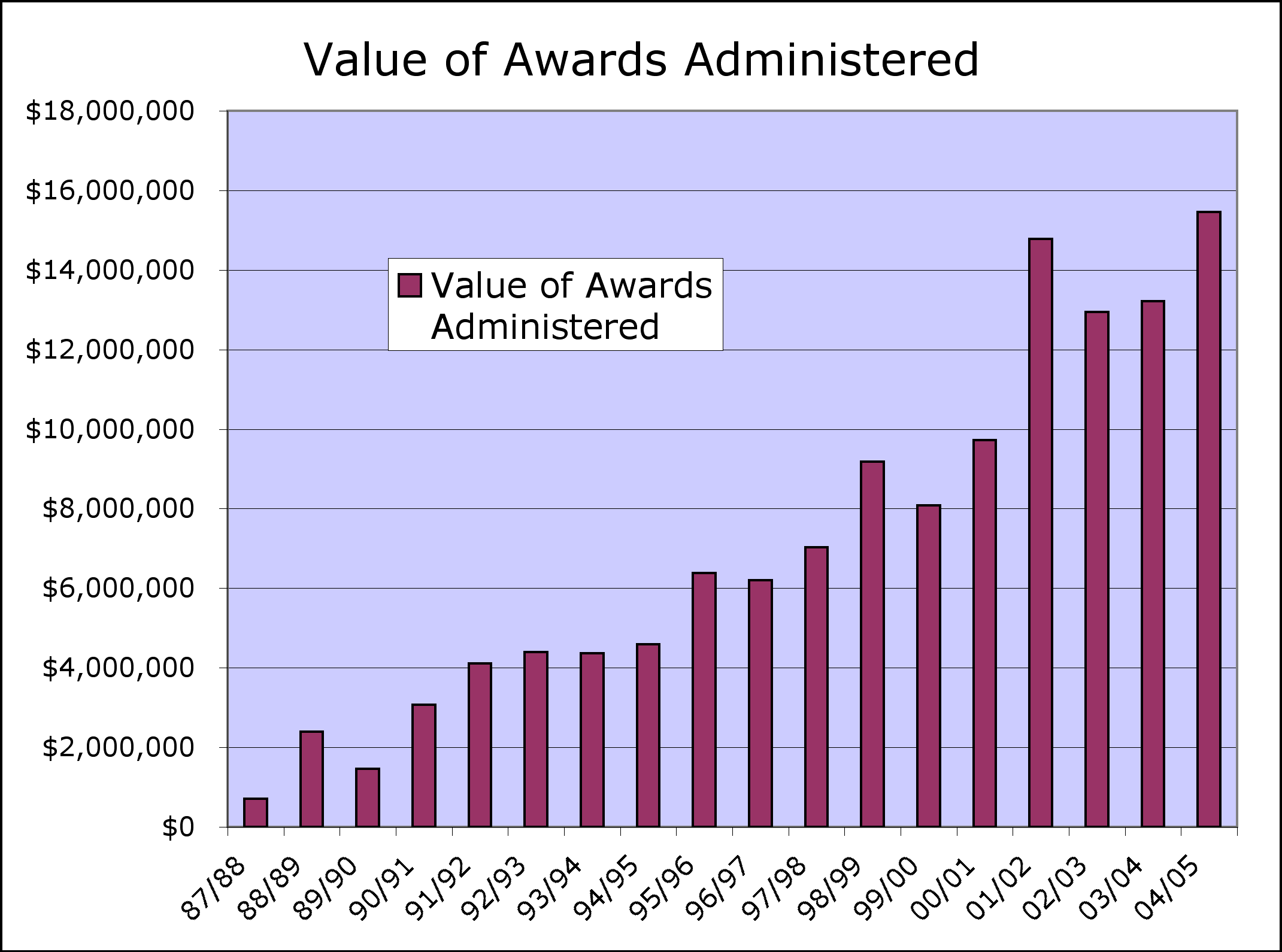
|
This expansion has facilitated a welcome addition of new space for ICS activities. Five offices contiguous to the existing ICS space in Webb became available this spring and have become the new home space for NEES @ UCSB. This is the nexus for the UCSB participation in the George E. Brown, Jr. Network for Earthquake Engineering Simulation (NEES). Under the leadership of Jamie Steidl, NEES @ UCSB developed permanently instrumented field sites for the study of soil-foundation-structure interactions during seismic shaking over the past few years. The site is now being used to examine strong ground motions and their effects on human-built structures during southern Californian earthquakes, as well as in response to induced shaking.
ICS and UCSB continue to participate as a core institution in the Southern California Earthquake Center (SCEC), a strikingly innovative and energetic organization that is defining the forefront of earthquake research in the US. Professor Ralph Archuleta has played an increasingly visible and important role in guiding the Center's research agenda through his role as assistant director. We recently learned from NSF and USGS officials that SCEC III will be funded through 2012.
ICS is home to two community-based research or data-base efforts. The Portable Broadband Instrument Center (PBIC) maintains and deploys seismometers whenever a major earthquake occurs in southern California, as well as for use in field experiments. This instrument pool is presently undergoing its first major update this decade. ICS staff and faculty maintain and continue to build the Consortium of Organizations for Strong-Motion Observation Systems (COSMOS) Virtual Data Center: an unrestricted web portal for strong-motion seismic records from the US and 14 other countries. ICS researchers maintain and continually update arrays of downhole seismometers and associated communication facilities at three different sites in southern California.
Following a three-year faculty search in geophysics, seismologist Chen Ji (from Caltech) was hired in the Department of Earth Science this past year. Chen brings a specialty in earth rupture dynamics that merges observational seismology with intense computational modeling. The 64-node computing cluster he is presently building will both underpin his research and provide a truly valuable computing resource for ICS researchers who are increasingly analyzing massive suites of data that require intensive computational investment.
For example, extensive remote sensing data on tropical rainfall from NASA's Tropical Rainfall Measurement Mission has been recently analyzed by ICS researchers with unprecedented spatial and temporal detail to reveal the precipitation variability of the Himalayan monsoon. New understanding of this variability underpins predictions of flooding, hillslope stability, erosion rates, and the health of glaciers in this developing region.
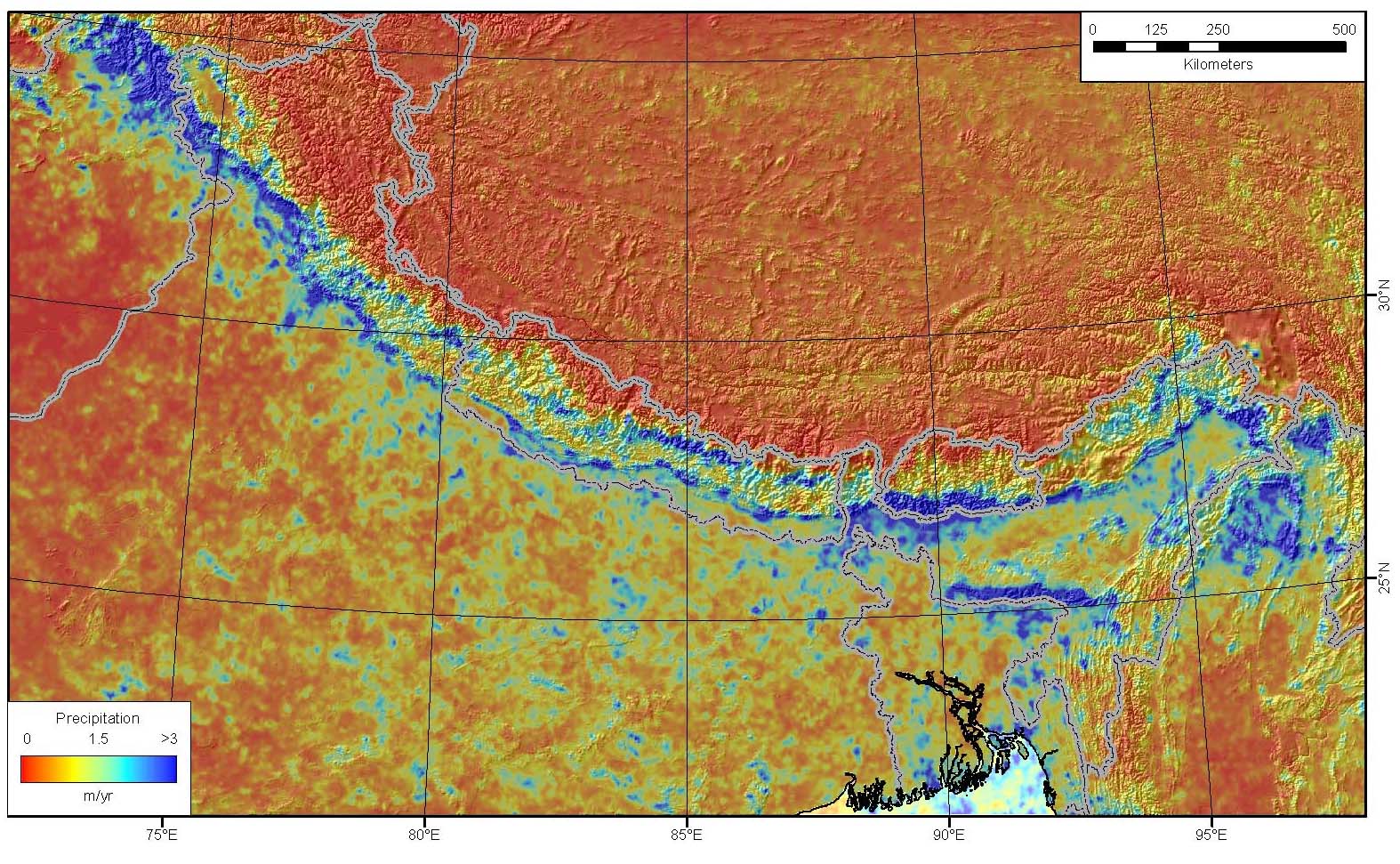
Each summer the Indian monsoon sweeps northward from the Bay of Bengal and collides with the Himalaya. This image of 7 years of summer rainfall data reveals for the first time some of the complex structure in the spatial patterns of rainfall. The double band of high precipitation (blue) occurs along the outer ridge of initial high topography (the Lesser Himalaya) and then along the southern flank of the High Himalaya. A profound rain shadow to the north of the main Himalayan crest is pervasive.
Outreach efforts by ICS researchers also extend to the Himalaya. Graduate student Beth Pratt-Sitaula has organized the "Oneworld School Project" that is currently facilitating an exchange between Nepali and Goleta elementary students and raising funds to bring educational materials to the partner Nepali schools. As a result of these efforts, microscopes, thermometers, barometers, and precipitation gauges were delivered in 2004 , and each school now has enough supplies (including lenses, prisms, chemicals and glassware) to conduct basic science demonstrations in physics and chemistry. Beth's article about Oneworld (Connecting people to science in the Himalaya) was featured in the Education section of Geotimes in November.
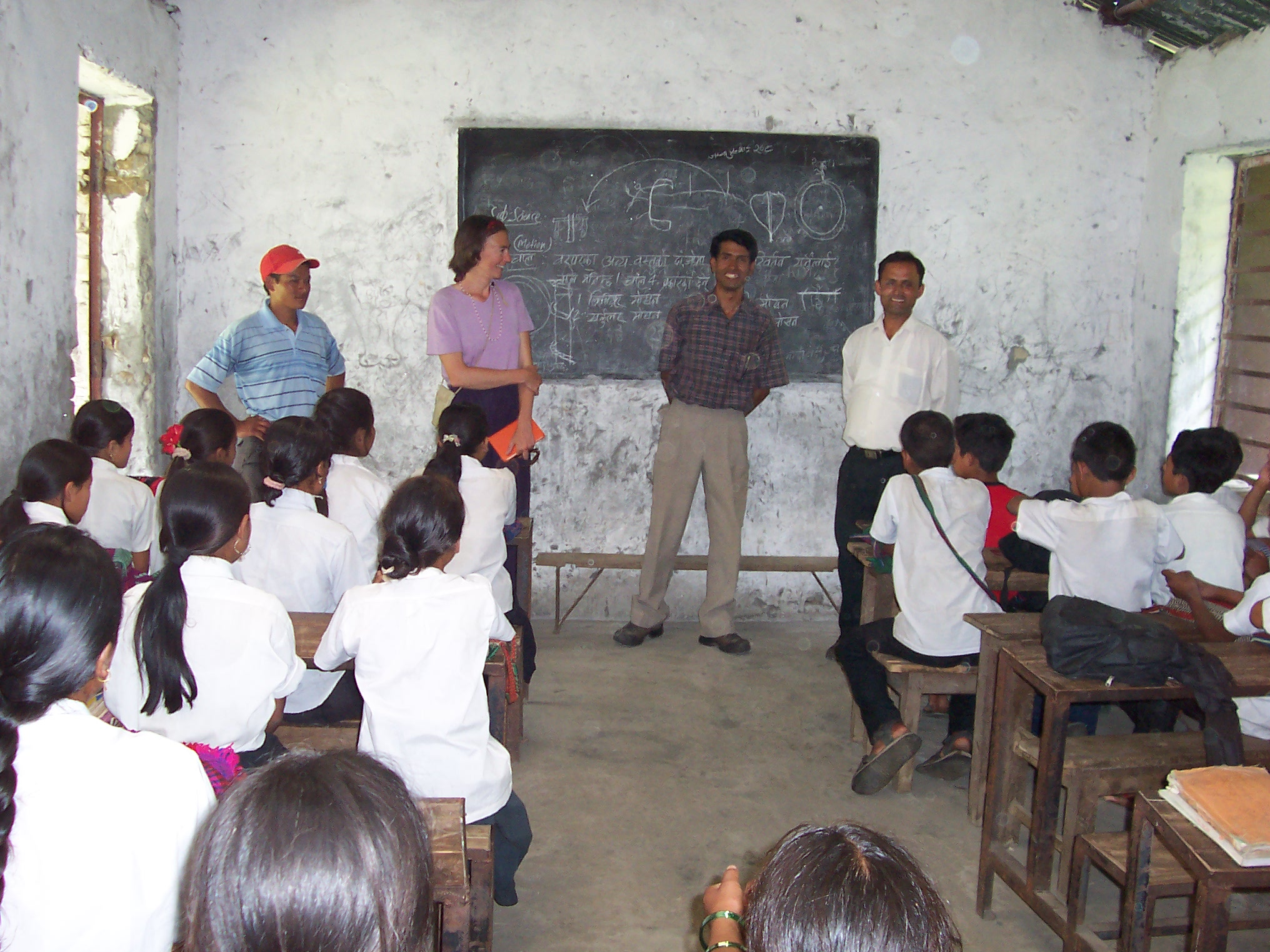
Graduate student Beth Pratt-Sitaula with Nepalese counterparts in a school at the toe of the High Himalaya. Beth delivered both scientific equipment for teaching and packets of letters that continue the exchange of correspondence between students in Goleta with those in central Nepal.
Several factors combined to make this a less stellar year for ICS in terms of externally funded research. Several productive researchers have been lured to permanent faculty positions at other universities (Kneller to Aberdeen; Niemi to Michigan). Proposal success rates at several key NSF programs declined to <7%. The funds for a number of proposals awarded in the winter or spring of 2005 didn't arrive at UCSB until the new fiscal year. The net result was that funding was down ~$0.7M below the previous year. Whereas the value of the new awards remains about double what it was in the 1990s, the numbers this year were a bit disappointing. With the addition of new faculty and researchers in ICS, we expect these figures to rebound next year.
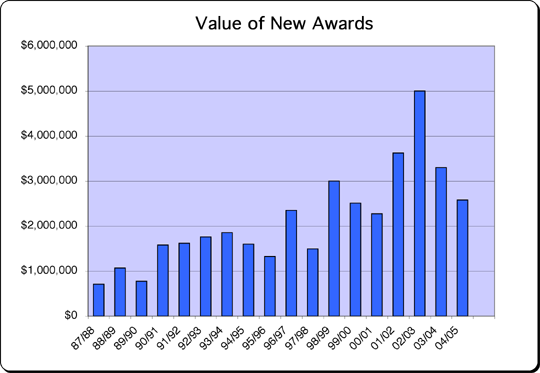
|

|
Adminstrative staff of ICS remained stable this year and continued to provide the expert advice and skills required for the smooth and efficient functioning of ICS. The vital role played by this staff in an environment of shrinking support and rising demands cannot be underestimated. Similarly, our CNT administers more than 100 network connections in four different buildings, he services at least 3 operating systems, and he runs all of the back-up and systems maintenance operations. Despite his part-time status, our CNT did an excellent job of administering over 100 computers, solving daily computing issues, and providing the long-term back-up and stability required for ICS computing needs.

In sum, the Institute of Crustal Studies continued this past year to do what is does best: foster high-quality research, enhance community outreach and education, and broaden the range of studies under its purview. We are proud that a couple of our ICS researchers were recruited to tenure-track faculty positions at major universities during the past year. On the other hand, the loss of five such researchers in the past two years has clearly impacted our external funding. We are working to rebuild this pool of productive researchers in the near future. In terms of staffing, our biggest need is to have full-time support for our CNT. Given his broad responsibilities and diligence, but over-extended commitments, such increased support is both appropriate and necessary.
